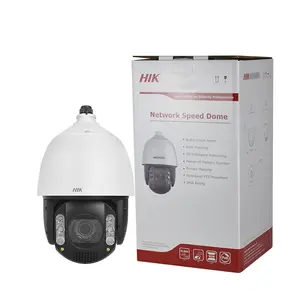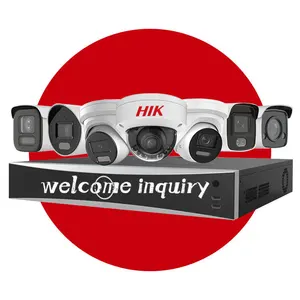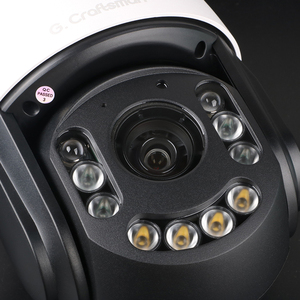(107634 products available)








































































































































































































PTZ cameras are available in several configurations suited for various settings, from surveillance to event broadcasting.
They include the following types:
Indoor PTZ Cameras
PTZ dome cameras for indoor use are designed with a focus on aesthetics and quiet operation. They are primarily used in areas like offices, retail stores, and educational institutions. Many of these cameras come with advanced features like facial recognition, which enhances security monitoring in critical areas.
Outdoor PTZ Cameras
Outdoor PTZ cameras are built to withstand harsh weather conditions, including rain, snow, and extreme temperatures. These cameras are designed for outdoor surveillance. Their robust housings and environmental seals ensure reliable operation in extreme conditions.
IP PTZ Cameras
IP PTZ cameras use internet protocol for video transmission, allowing for remote access and control over the internet. Businesses can access live feeds from anywhere using smartphone apps or web browsers. The cameras also often come integrated with advanced features such as analytics and cloud storage.
Self-Tracking PTZ Cameras
Self-tracking PTZ cameras are automatic and do not require manual control. They come with motorized heads that can tilt, pan, and zoom to capture objects or subjects that users have marked on a touchscreen display. These cameras are commonly used in event filming and sports broadcasting so operators can focus on other essential aspects of the shoot.
PTZ Security Cameras
PTZ security cameras are primarily used in surveillance applications, offering features like 360-degree pan and 90-degree tilt. They are used in areas like parking lots, perimeter fencing around industrial sites, and critical infrastructure to enhance intrusion detection.
PTZ cameras are made from premium materials to ensure functionality in critical situations. They also offer various durability features that directly impact their performance in different environments.
Metal Housings
Many outdoor PTZ cameras have a metal housing, typically aluminum or stainless steel. These cameras protect the internal components from damage due to physical impact, UV exposure, and environmental conditions. Metal housings are commonly used in industrial and outdoor applications where cameras need resilience against vandalism and extreme weather conditions.
Waterproof Ratings
Most outdoor PTZ cameras establish a minimum IP65 or IP66 waterproof rating. This rating allows the camera to operate normally as intended in heavy rain or snow. The sealing methods used to achieve these ratings typically include silicone or rubber gaskets around the camera's lens and housing covers.
Anti-Vandal Features
Many outdoor PTZ dome cameras incorporate anti-vandal features. These include reinforced glass covers to prevent breaking and mounting brackets designed to secure the camera against tampering. These features enhance surveillance in public areas like streets, parks, and transportation hubs.
Surge Protection
Many PTZ cameras, especially those used in outdoor settings, include surge protection to safeguard against voltage spikes. These spikes can be caused by lightning strikes or electrical surges in power lines. Cameras with surge protection are critical for maintaining functionality in severe weather conditions.
Quality Lenses
PTZ cameras, especially in professional applications, have premium varifocal lenses made of glass with anti-reflective coatings to resist scratches. High-quality lens materials improve image clarity and reduce distortions in various weather elements.
PTZ cameras, with their advanced features and versatility, have numerous benefits for businesses. They enhance security, improve operational efficiencies, and reduce costs.
Increased Coverage with Fewer Cameras
Unlike fixed cameras, PTZ cameras can cover multiple areas by adjusting their field of view. This adaptability means businesses can achieve broader surveillance coverage with fewer cameras. This leads to significant savings in initial investment and installation costs.
Remote Monitoring
PTZ camera systems allow people to control the camera from remote locations. It helps businesses operate efficiency by monitoring key areas from anywhere, whether on-site or off-site. This flexibility reduces the need for security personnel to be physically present at all times. It enables real-time responses to potential incidents and enhances overall security effectiveness.
High-Quality Video for Better Decision-Making
PTZ cameras typically have high-definition video capabilities. Their resulting video quality ensures that businesses have clear, detailed footage for various needs, including security, operational monitoring, and customer analytics. This clarity aids law enforcement in evaluating incidents and helps management identify areas for improvement.
Integration with Other Systems
PTZ cameras easily integrate with other systems, such as alarm and access control systems or video analytic software. This interoperability helps develop comprehensive security solutions that enrich businesses' operational efficiency. These integrations help automate alerts, streamline responses to security breaches, and enhance overall situational awareness.
Scalability and Flexibility
PTZ cameras fit varied business needs across industries. Whether a business expands its physical footprint or upgrades its technology, PTZ cameras provide a scalable solution to adapt its surveillance infrastructure. Their adaptability ensures businesses can meet evolving security threats without incurring significant additional costs.
One must consider various factors to select the appropriate camera for various business applications. These include:
Field of View
Choosing the suitable PTZ requires understanding the optimal field of view for the intended space. A camera with a wide-angle lens provides a broader perspective, ideal for large open areas. Conversely, one with a narrow field of view is better for focusing on detail in smaller enclosed spaces. Retail environments and warehouses typically call for wide-angle PTZs to eliminate blind spots and monitor customer activity or foot traffic efficiently.
Zoom Capability
The zoom capability of a PTZ camera significantly impacts the image's clarity, especially when viewing objects from long distances. Cameras with power zoom lenses enable users to adjust the zoom level remotely to capture detailed views of a scene or a broad overview. This feature is particularly valuable in outdoor surveillance, where varying distances might need to be monitored.
Durability
The PTZ camera's durability is crucial, especially when used in critical or exposed locations. Consider cameras rated IP66 or higher, designed to endure severe weather conditions, including heavy rainfall and snow. Models that incorporate anti-vandal measures, like reinforced housings or tamperproof designs, offer additional protection against potential threats. Cameras constructed with corrosion-resistant materials, such as stainless steel, also have greatly enhanced longevity by keeping their functionality intact over years of use.
Image Quality
Users should prioritize cameras featuring high-resolution imaging, such as 1080p or 4K, for premium clarity and detail. Ensure the camera has advanced image processing technologies. These technologies improve footage quality in low-light conditions, particularly important for nighttime surveillance. Cameras equipped with superior-quality lenses, such as varifocal or optical zoom lenses, also contribute to enhanced image sharpness and overall quality.
Budget
PTZ cameras are available in a wide range of prices depending on their operational features. Retail customers on a tight budget will prefer models with essential basic features like remote panning and tilting functions. They will not be too concerned if the camera lacks integrated video analytics. At the same time, businesses planning to install a PTZ in critical areas where threats are expected might not mind investing in high-end models.
A1. PTZ stands for pan-tilt-zoom. These cameras offer remote-controlled movement along horizontal (panning and tilting) and zooming) axes. It allows users to track subjects dynamically and capture images from different angles and focal lengths.
A2. Fixed cameras have a constant view and are not movable. They can be mounted at specific angles to cover a particular area. PTZ cameras can be adjusted for different field-of-view angles. They allow users to zoom in for detailed views or zoom out for broader coverage.
A3. Several PTZ cameras are designed for indoor functions. Their designs enable users to watch specific internal areas, such as conference rooms or lobbies. That makes them perfect for event broadcasting, live streaming, or corporate surveillance.
A4. Many modern PTZ cameras come with night-vision capabilities. They use infrared LEDs to illuminate the area, allowing clear footage even in total darkness. Others have light-sensitive lenses that automatically switch between daytime and nighttime modes.